
10 Innovative Bio Plastic Solutions for Sustainable Manufacturing
Introduction
The urgency for sustainable practices is more pressing than ever, right? Bioplastics are stepping into the spotlight as innovative solutions for manufacturing. As industries look to shrink their environmental footprint, biodegradable materials are popping up as promising alternatives to traditional plastics. This shift not only opens doors for new opportunities but also has the potential for a significant ecological impact.
But here’s the kicker: with so many options emerging, how can businesses navigate this evolving landscape? It’s a bit of a maze out there! The challenge lies in leveraging the potential of bioplastics to meet both regulatory demands and what consumers are looking for. So, let’s dive into this together and explore how we can make the most of these exciting developments!
Lincoln Plastics: Custom Extrusion Solutions for Bioplastics
You know, many industries today are grappling with the challenge of sustainability. That’s where Lincoln Plastics comes in! They really shine in custom profile extrusion, offering bio plastic solutions that are specifically tailored to meet the unique needs of different sectors.
By using advanced extrusion methods, Lincoln Plastics crafts high-quality biodegradable plastics that are not just functional but also eco-friendly. Imagine being able to use products that help the planet while still getting the job done! Plus, their innovative approach allows them to co-extrude multiple materials, which means they can create unique product features that boost performance and reduce environmental impact.
As a leader in the biodegradable plastics industry, Lincoln Plastics is committed to promoting bio plastic solutions to support the shift to sustainable manufacturing. They want to help clients achieve their operational goals while sticking to eco-friendly standards. And you might be wondering, why is this important? Well, industry leaders are emphasizing the need to integrate sustainability into manufacturing processes, and Lincoln Plastics is right there at the forefront, reinforcing the role of bioplastics in building a more responsible future.
So, if you’re looking to make a positive change in your operations, why not consider bioplastics? It’s a step towards sustainability that can really make a difference!
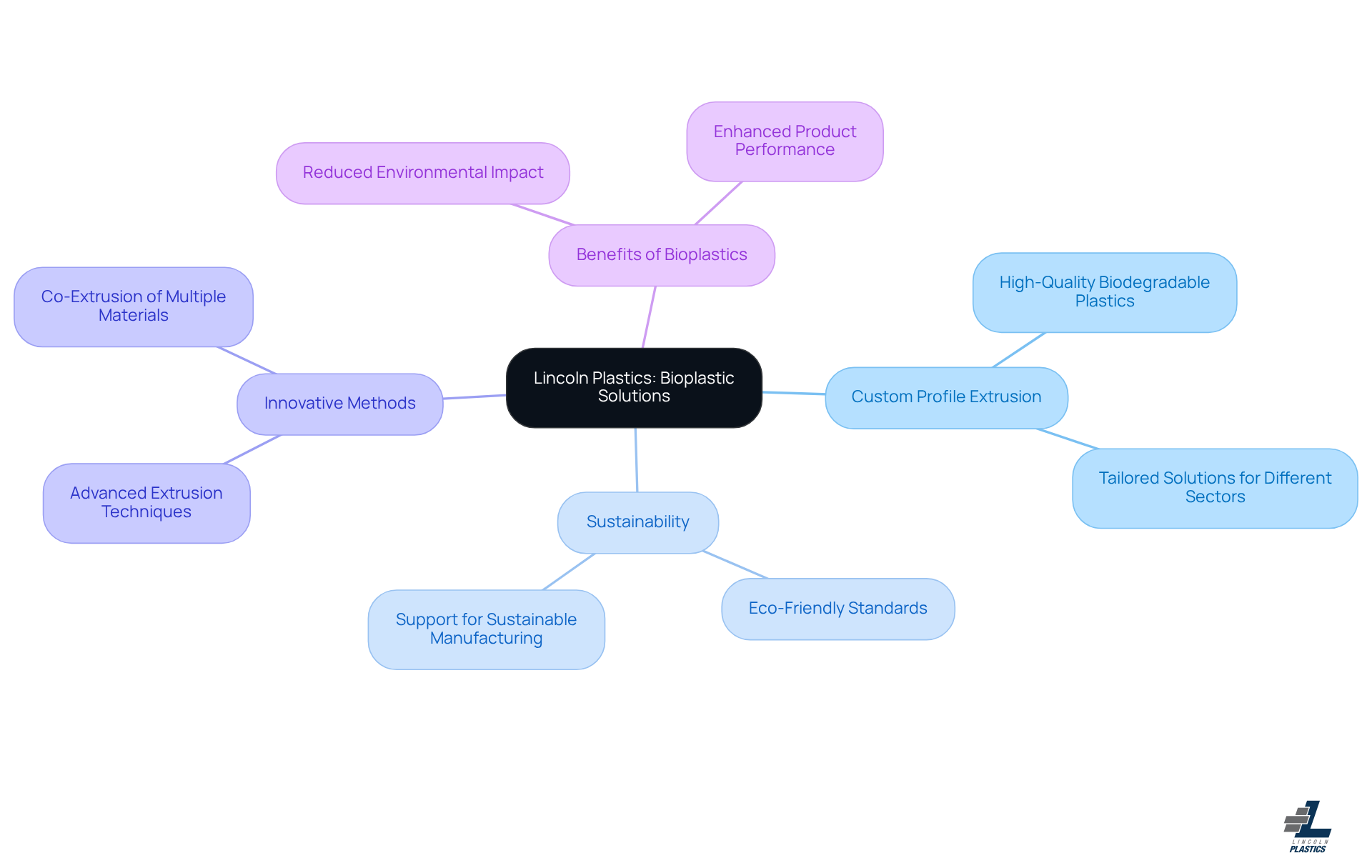
Shrilk: Degradable Bioplastic from Shrimp Shells and Silk Protein
Have you ever thought about the impact of plastic on our environment? Well, let me introduce you to Shrilk - a game-changing bioplastic made from shrimp shells and silk protein. It combines the tough properties of chitin with the stretchy nature of silk fibroin. What’s cool about Shrilk is that it’s completely biodegradable! When you compost it, it breaks down into harmless carbohydrates and proteins, making it a fantastic alternative to traditional plastics.
Now, Shrilk isn’t just eco-friendly; it’s versatile too! You can find it in packaging and medical devices, where its ability to biodegrade really helps reduce environmental harm. Plus, it’s as strong as aluminum alloys, which means it could be a great option for lightweight automotive parts. As more industries look for greener solutions, Shrilk is stepping up as a major player in providing bioplastic solutions for sustainable materials.
Did you know the global bioplastics market was valued at around USD 15.57 billion in 2024? It’s projected to grow at a whopping 19.5% annually from 2025 to 2030! This shows just how much people are craving eco-friendly options. Researchers point out that using biodegradable materials like Shrilk contributes to bioplastic solutions that tackle plastic waste while also meeting the rising consumer demand for responsible products.
Companies are catching on too! Many are turning to Shrilk for bioplastic solutions in sustainable packaging, particularly within the food and beverage industry. They see its potential to keep products fresh while cutting down on their environmental impact. However, there are some challenges with shrimp production that might affect how readily available Shrilk is in the market.
But here’s the exciting part: the uses for Shrilk biopolymer are on the rise! Its unique features and the urgent need for alternatives to traditional materials are driving this growth. So, what do you think? Could Shrilk be the answer to our plastic problem?

Circe: Transforming Greenhouse Gases into Bioplastics
Have you ever thought about the impact of plastic waste on our planet? It’s a big issue, right? Well, the Circe project is stepping up to tackle this challenge by using engineered microbes to turn greenhouse gases, like carbon dioxide, into biodegradable materials. This innovative approach not only helps reduce plastic waste but also supports the implementation of bio plastic solutions that lower CO2 levels in the atmosphere.
By transforming waste gases into valuable materials, Circe is paving the way for a more sustainable manufacturing process. It’s exciting to see how this technology is making waves in the biodegradable materials sector, demonstrating the potential of bio plastic solutions and circular economy practices.
So, what does this mean for us? It’s a step forward in the fight against climate change, and it’s a reminder that we can all contribute to a healthier planet. Let’s keep the conversation going and explore how we can support such initiatives!

Bioplastics: A Solution to Plastic Pollution Challenges
Have you ever thought about the mess synthetic materials are making in our world? Bio plastic solutions might be the answer we need! Unlike traditional plastics, many biodegradable options are designed to break down, which means they leave a much smaller ecological footprint. By swapping out petroleum-based materials for eco-friendly alternatives made from renewable resources, industries can really cut down on the harmful effects of waste on our ecosystems.
Now, let’s talk about why this shift is so important. Not only does it tackle pollution, but it also encourages responsible resource management. This makes bio plastic solutions a key player in the future of manufacturing. In fact, the global market for biodegradable materials is expected to hit around $6.9 billion by 2025! That’s a clear sign that more people are recognizing their ecological benefits.
Different industries, like packaging, agriculture, and consumer products, are jumping on the biodegradable bandwagon. Why? Well, they’re feeling the pressure from regulations and hearing the call from consumers who want eco-friendly options. Environmental advocates are excited about this shift, too, as they believe that moving to biodegradable materials can significantly reduce waste in landfills and oceans. And guess what? That’s great news for both wildlife and human health!
As the urgency to deal with waste from synthetic materials grows, bio plastic solutions are emerging as a crucial part of creating a greener future. So, what do you think? Isn’t it time we all start considering these eco-friendly options?
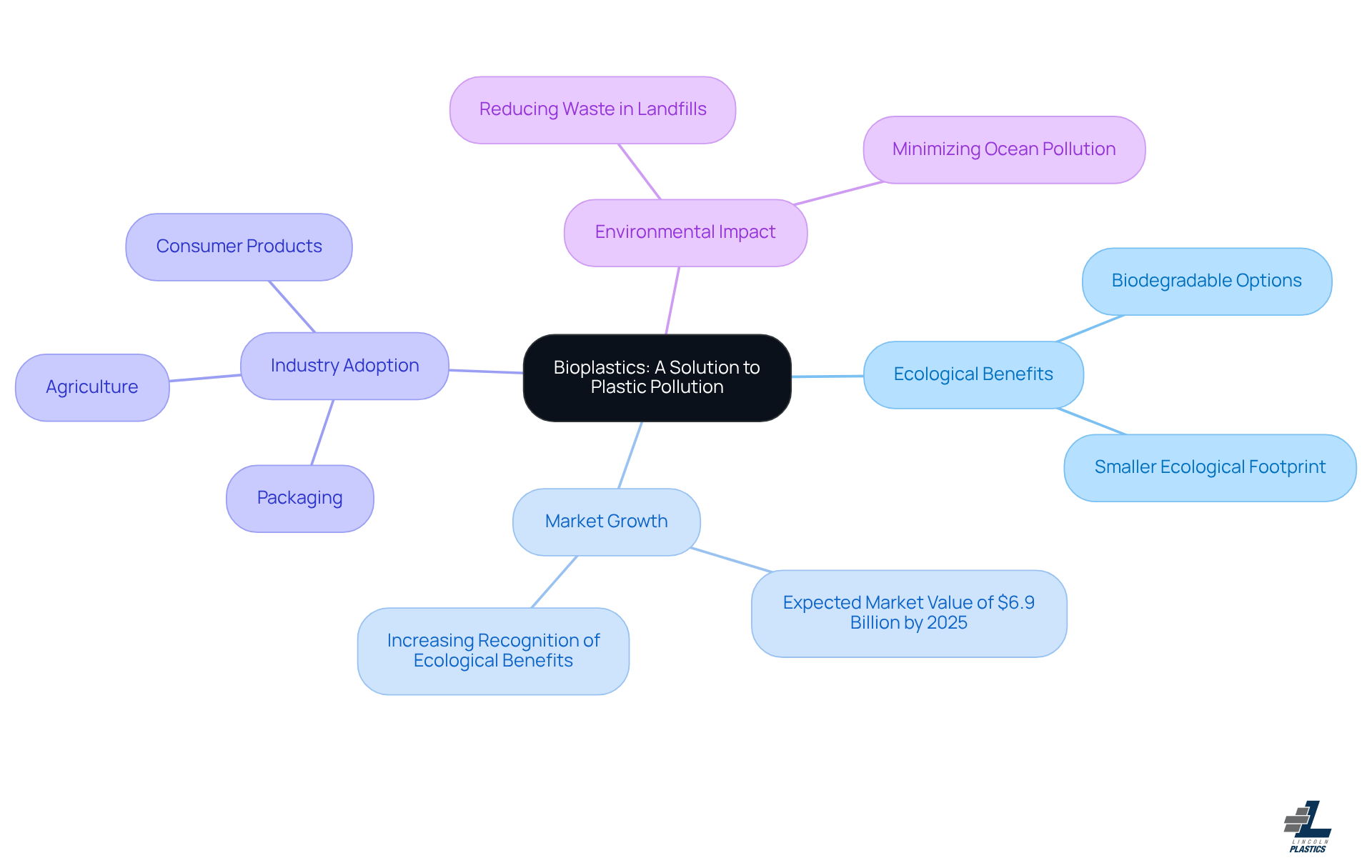
Sustainable Manufacturing: The Rise of Bioplastics
You know, the buzz around bio plastic solutions is really picking up, and it’s all thanks to our growing demand for eco-friendly products and the push from regulations to cut down on plastic waste. Manufacturers are jumping on board, using bio plastic solutions and other sustainable materials to boost their green credentials and meet the expectations of consumers who care about the planet. This shift not only helps companies stay compliant with the rules but also positions them as trailblazers in adopting bio plastic solutions for a circular economy.
Now, let’s talk numbers. The global market for bio-based plastics was valued at a whopping USD 15.57 billion in 2024, and it’s projected to soar to USD 44.77 billion by 2030. That’s a compound annual growth rate (CAGR) of 19.5%, with some forecasts even suggesting a CAGR of 21%! It’s pretty clear that the adoption of bio plastic solutions is making waves across various industries, from packaging to automotive and consumer products, all in response to the rising need for eco-friendly solutions.
And here’s something to think about: biodegradable plastics are expected to be in higher demand than their non-biodegradable counterparts. As technology continues to advance, we can expect the integration of bio plastic solutions into manufacturing processes to accelerate, reinforcing their role in sustainable practices. So, what do you think? Isn’t it exciting to see how these innovations can help us tackle environmental challenges?

Reducing Fossil Fuel Dependence with Bioplastics
Bioplastics are pretty cool, right? They come from renewable materials like plants, and they’re key to cutting down our dependence on fossil fuels. By using agricultural by-products and other sustainable sources, we can create these innovative materials with a much smaller carbon footprint than traditional plastics. Just think about it: the world churns out over 400 million tons of synthetic materials every year, with at least 11 million tons ending up in our oceans. That’s a big wake-up call for us to find alternatives such as bio plastic solutions.
Now, why does this matter? Transitioning to bio plastic solutions not only helps us save our precious fossil resources but also boosts energy efficiency in how we make things. As more industries jump on the sustainability bandwagon, utilizing bio plastic solutions becomes a must for achieving energy independence and cutting down greenhouse gas emissions.
You might be wondering about the performance of these bioplastics. Well, recent advancements in biopolymer production, especially with materials like PHA and PLA, show that they can match or even outshine traditional synthetics. This makes them a fantastic choice for eco-friendly manufacturers looking to make a difference.
And let’s not forget what Sir David Attenborough says: tackling plastic pollution is crucial for the health of our oceans and ecosystems. So, making the switch to alternative plastics isn’t just a good idea-it’s essential for our planet's future!
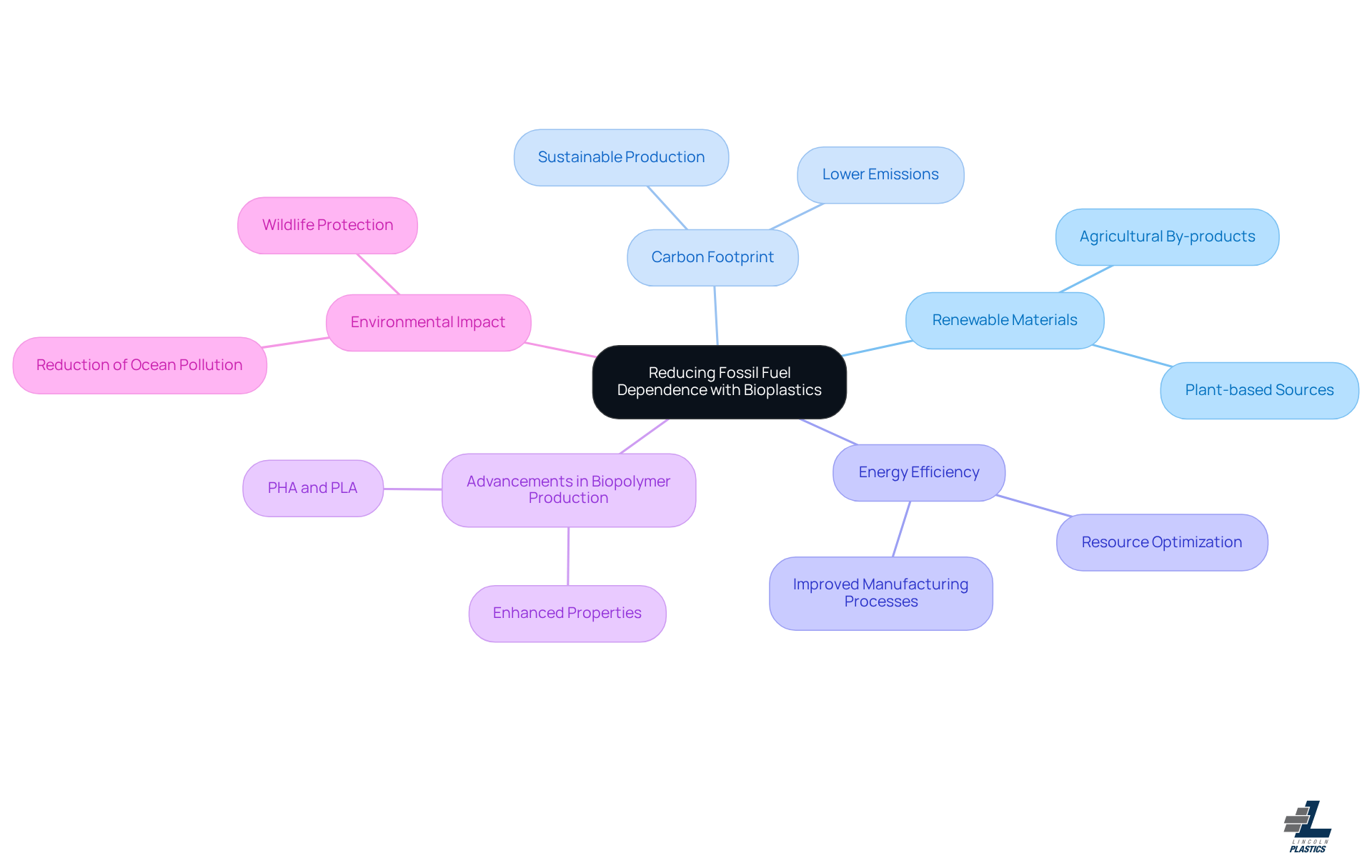
Innovations in Bioplastic Technology: Shaping the Future
Have you noticed how bioplastics are making waves lately? Recent innovations in bio plastic solutions have resulted in some pretty exciting new materials. These materials come with enhanced properties like improved strength, flexibility, and biodegradability. Plus, advances in processing methods - think 3D printing and injection molding - are opening up new doors for bio plastic solutions across various sectors.
Now, here’s the kicker: these technological breakthroughs not only boost the performance of sustainable plastics but also make them more accessible and affordable for manufacturers. Can you believe the bioplastic market was valued at USD 16.8 billion in 2025? It’s projected to skyrocket to USD 98 billion by 2035! This growth is fueled by rising consumer awareness and corporate sustainability initiatives.
As research keeps evolving, the future of biodegradable plastics looks bright. We’re talking potential applications in packaging, automotive, and consumer goods sectors. But hold on a second - experts are cautioning us. While bio-based plastics offer a sustainable option, we still need to tackle issues like the thermal instability of PLA and the possible toxicity of microplastics from these materials.
So, what’s the takeaway? The ongoing advancement of bio plastic solutions is crucial for addressing environmental challenges while meeting the needs of modern manufacturing. Let’s keep the conversation going about how we can support these innovations!
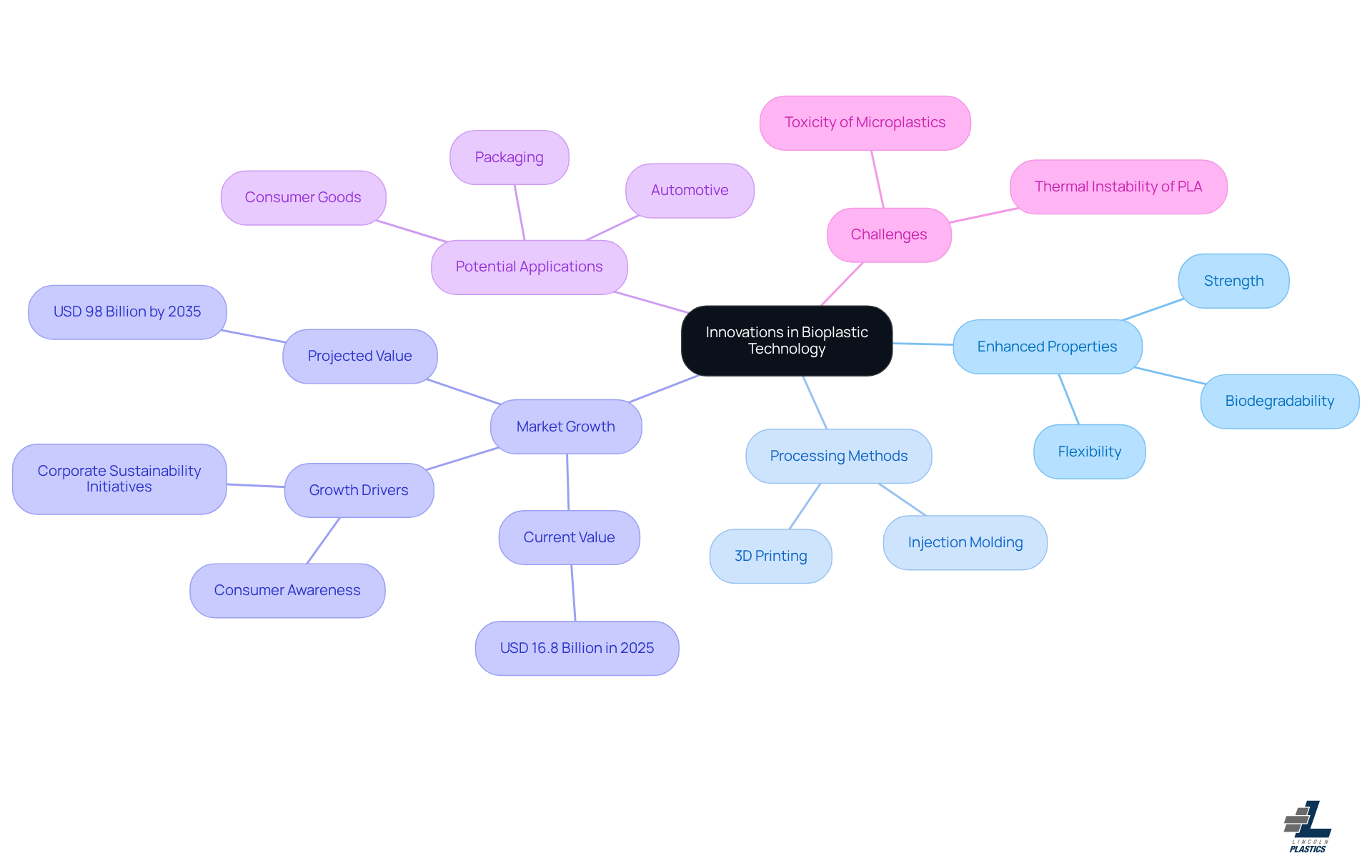
Market Trends: Consumer Preferences for Bioplastics
You know, consumer preferences are really shifting these days, especially when it comes to biodegradable plastics. With more folks becoming aware of environmental issues, it’s no surprise that recent surveys show a whopping 80% of consumers are ready to shell out a bit more for sustainably produced goods. On average, that’s about a 9.7% premium! This shift in buying habits is prompting producers to step up their game and incorporate sustainable materials into their products.
Now, here’s something interesting:
- 52% of consumers consider sustainability a top purchase criterion, and half of them list it among their top four criteria.
- That really highlights how important eco-conscious practices have become in today’s manufacturing landscape.
- About 31% of consumers are worried about inflation being the biggest risk to their spending habits over the next year, which definitely plays a role in their purchasing decisions.
As companies increasingly embrace bio plastic solutions, we can expect growth in the industry. This growth will likely spark even more creativity and funding in bio plastic solutions and other eco-friendly materials. And it doesn’t stop there-consumers are also looking at sustainability practices through the lens of production techniques (40%) and environmentally friendly packaging (38%). This further pushes companies to enhance their sustainability initiatives and stay competitive in this fast-changing environment.

Regulatory Landscape: Impact on Bioplastics Industry
You know, the world of biodegradable materials is really shifting right now. Governments everywhere are stepping up, putting policies in place to promote sustainable options and cut down on waste. It’s a big deal! Regulations that limit single-use plastics and advocate for bio plastic solutions are shaking things up in the biopolymer industry.
So, what does this mean for businesses? Well, staying compliant with these new rules not only boosts your brand’s reputation but also opens up exciting new market opportunities. It’s like a win-win! As the regulatory landscape keeps changing, it’s super important for companies focusing on bio plastic solutions to stay on top of these updates.
Now, let’s talk about how you can navigate this evolving environment. Keeping an eye on these regulations can really set you apart in the market. Are you ready to embrace these changes and lead the way in sustainability?
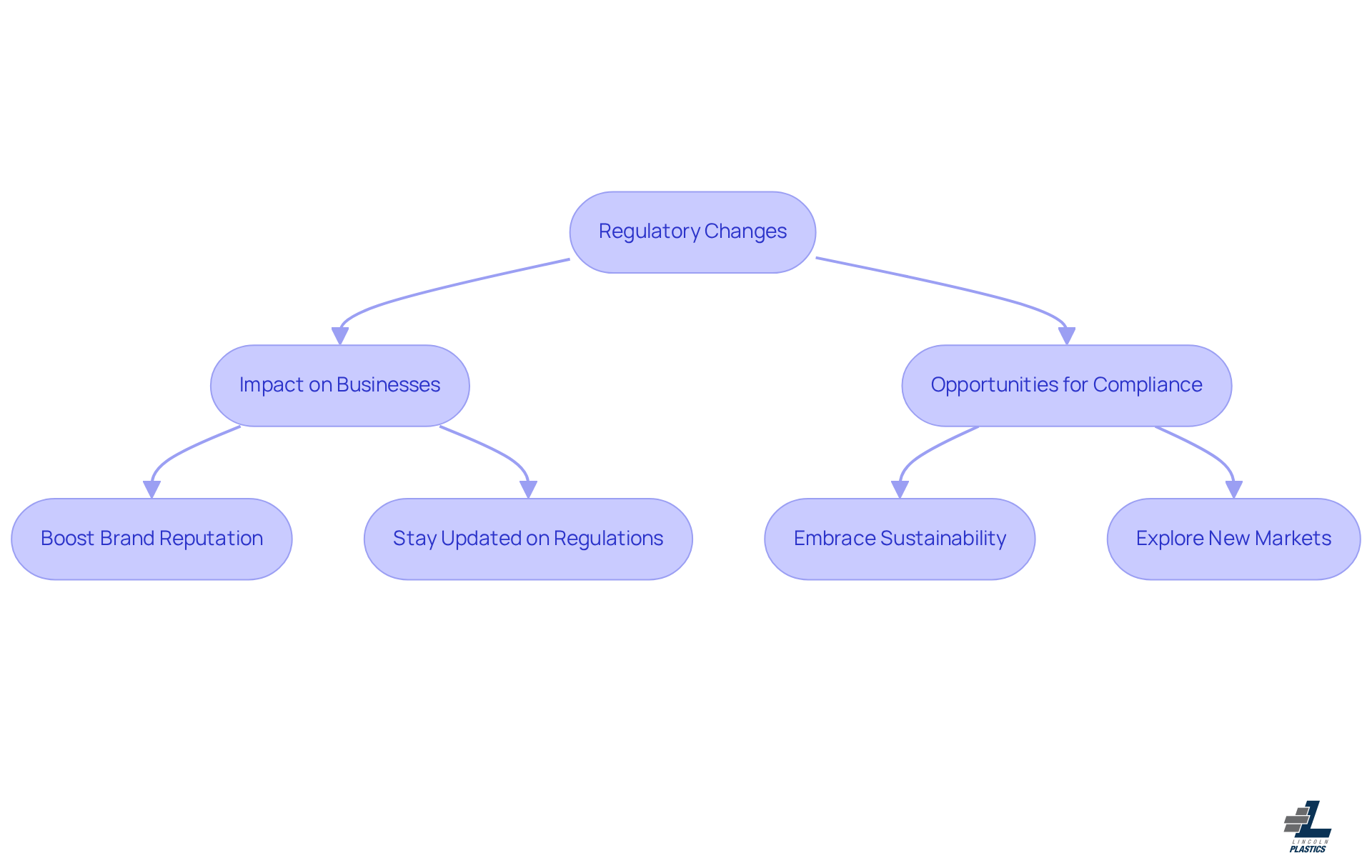
Collaborative Efforts: Advancing Bioplastics Through Partnerships
Joint initiatives among industry players, including producers, researchers, and regulators, are essential for progressing with bio plastic solutions technology. These partnerships allow for sharing knowledge, pooling resources, and launching joint research projects that spark innovation. For instance, when universities team up with companies, they often make significant strides in bioplastic materials and production processes.
Take the partnership between Emirates Biotech and the United Arab Emirates University, for example. They’re working together to boost the sustainability of polylactic acid (PLA) through some really innovative applications and end-of-life solutions. As Professor Mohamed H. Al-Marzouqi points out, this collaboration is right on target with today’s sustainability challenges and is crucial for meeting the rising demand for bio plastic solutions as eco-friendly alternatives to traditional plastics.
Now, let’s talk numbers. The global bioplastics market was valued at around USD 16.96 billion in 2025 and is expected to skyrocket to USD 76.78 billion by 2035. This really highlights how urgent and relevant these partnerships are in building a circular economy. So, what can we do? Let’s support these initiatives and keep the conversation going about sustainable solutions!

Conclusion
You know, exploring innovative bioplastic solutions really shows how manufacturing is shifting towards sustainability. By using materials that are biodegradable and come from renewable resources, industries can cut down their environmental impact while also catering to the growing demand for eco-friendly products.
Take Lincoln Plastics and Shrilk, for example. They’re leading the way in showing how advanced bioplastic technologies can tackle plastic pollution and reduce our reliance on fossil fuels. The Circe project is a fantastic illustration of this potential, turning greenhouse gases into valuable biodegradable materials. It’s exciting to see the innovative spirit that’s driving this sector!
And let’s not forget about the rising consumer preferences for sustainable options and the supportive regulatory frameworks that are popping up. These trends point to a bright future for bioplastics across various industries.
As the bioplastics market keeps growing, it’s essential for both businesses and consumers to recognize how important it is to adopt these sustainable materials. By prioritizing bioplastics, industries can not only meet regulations but also play a part in a circular economy that benefits our planet and future generations. Embracing these innovations isn’t just a passing trend; it’s a crucial step toward a more sustainable and responsible manufacturing landscape.
Frequently Asked Questions
What is Lincoln Plastics known for?
Lincoln Plastics specializes in custom profile extrusion, offering biodegradable plastic solutions tailored to meet the unique needs of various industries.
How does Lincoln Plastics contribute to sustainability?
They create high-quality biodegradable plastics using advanced extrusion methods, promoting eco-friendly products that help reduce environmental impact while meeting operational goals.
What innovative techniques does Lincoln Plastics use?
They utilize co-extrusion techniques to combine multiple materials, allowing for unique product features that enhance performance and sustainability.
Why are bioplastics important in manufacturing?
Bioplastics support the shift towards sustainable manufacturing by integrating eco-friendly practices, which are increasingly emphasized by industry leaders.
What is Shrilk and what materials is it made from?
Shrilk is a biodegradable bioplastic made from shrimp shells and silk protein, combining the properties of chitin and silk fibroin.
What are some applications of Shrilk?
Shrilk is versatile and can be used in packaging and medical devices, as well as potentially in lightweight automotive parts due to its strength.
What is the projected growth of the global bioplastics market?
The global bioplastics market was valued at approximately USD 15.57 billion in 2024 and is projected to grow at an annual rate of 19.5% from 2025 to 2030.
How does Shrilk address environmental concerns?
Shrilk is completely biodegradable and breaks down into harmless carbohydrates and proteins, making it a responsible alternative to traditional plastics.
What challenges does Shrilk face in the market?
Challenges in shrimp production may affect the availability of Shrilk in the market, despite its potential for sustainable packaging solutions.
What is the Circe project focused on?
The Circe project uses engineered microbes to convert greenhouse gases, like carbon dioxide, into biodegradable materials, helping to reduce plastic waste and CO2 levels in the atmosphere.
How does the Circe project contribute to sustainability?
By transforming waste gases into valuable biodegradable materials, Circe promotes a more sustainable manufacturing process and supports circular economy practices.
What is the overall significance of bioplastics in addressing plastic waste?
Bioplastics, like those produced by Lincoln Plastics, Shrilk, and through initiatives like Circe, represent innovative solutions to tackle plastic waste while meeting the rising consumer demand for eco-friendly products.
List of Sources
- Lincoln Plastics: Custom Extrusion Solutions for Bioplastics
- Bioplastics Market Size, Growth, Share & Report Analysis 2030 (https://mordorintelligence.com/industry-reports/bioplastics-market)
- 15 Plastic Pollution Quotes to Inspire You to Go Waste Free | Earth.Org (https://earth.org/plastic-pollution-quotes)
- United States Bioplastics Market 2025 | Growth Drivers, Trends & Market Forecast, Competitive Landscape & Investment Opportunities (https://openpr.com/news/4240915/united-states-bioplastics-market-2025-growth-drivers-trends)
- 110 Powerful Sustainability Quotes for Life and Business (https://deliberatedirections.com/sustainability-quotes)
- 9 Thoughtful Eco Living Quotes for Plastic Free July — The Honest Consumer (https://thehonestconsumer.com/blog/eco-living-quotes-for-plastic-free-july)
- Shrilk: Degradable Bioplastic from Shrimp Shells and Silk Protein
- Bioplastics Market Size, Share, Growth Analysis Report 2030 (https://grandviewresearch.com/industry-analysis/bioplastics-industry)
- Shrilk Market Size, Share, Growth, Future Prospect & Forecast 2033 (https://straitsresearch.com/report/shrilk-market)
- Market (https://european-bioplastics.org/market)
- Bioplastics: A Solution to Plastic Pollution Challenges
- 15 Plastic Pollution Quotes to Inspire You to Go Waste Free | Earth.Org (https://earth.org/plastic-pollution-quotes)
- 55 Plastic Pollution Quotes to Inspire Change & Action (https://thrivingsustainably.com/plastic-pollution-quotes)
- Natureworks: Market Development for Bioplastics | Marketing Case Studies (https://ibscdc.org/Case_Studies/Marketing/Marketing/Natureworks-Market Development for Bioplastics-Case Study.htm)
- Plastics in the health sector | Health Care Without Harm - Global (https://global.noharm.org/focus/plastics/case_studies)
- Sustainable Manufacturing: The Rise of Bioplastics
- Bioplastics Market Size, Share, Growth Analysis Report 2030 (https://grandviewresearch.com/industry-analysis/bioplastics-industry)
- Bioplastics Global Overview Report 2025: Global Market to Reach $44.3 Billion by 2030 from $14.1 Billion in 2024 - ResearchAndMarkets.com (https://businesswire.com/news/home/20250312749659/en/Bioplastics-Global-Overview-Report-2025-Global-Market-to-Reach-$44.3-Billion-by-2030-from-$14.1-Billion-in-2024---ResearchAndMarkets.com)
- Global Bioplastics Market Accelerates Toward 5634.6 Kilotons (https://bccresearch.com/pressroom/pls/global-bioplastics-market-accelerates-toward-56346-kilotons?srsltid=AfmBOorsz979hCckAuMfINgerAC8mACJRCXaueWXshIV7MHjhybx-W3y)
- Bioplastics & Biopolymers Market worth $45.04 billion by 2030 (https://marketsandmarkets.com/PressReleases/biopolymers-bioplastics.asp)
- Market (https://european-bioplastics.org/market)
- Reducing Fossil Fuel Dependence with Bioplastics
- 55 Plastic Pollution Quotes to Inspire Change & Action (https://thrivingsustainably.com/plastic-pollution-quotes)
- What Are the Advantages of Bioplastic Products for Different Industries? (https://made-with-regen.ca/blog/advantages-of-bioplastics)
- 15 Plastic Pollution Quotes to Inspire You to Go Waste Free | Earth.Org (https://earth.org/plastic-pollution-quotes)
- Innovations in Bioplastic Technology: Shaping the Future
- Vision of the future: bioplastics as the key to sustainability (https://bayern-innovativ.de/en/detail/vision-of-the-future-bioplastics-as-the-key-to-sustainability)
- "The fact is that we as an industry are responsible to build a circular economy for all types of packaging." | Packaging News (https://packagingnews.co.uk/supplier-network/wessex-packaging/case_studies/fact-industry-responsible-build-circular-economy-types-packaging)
- Plastics in the health sector | Health Care Without Harm - Global (https://global.noharm.org/focus/plastics/case_studies)
- Bio-plastics Market Growth & Trends, 2025 to 2035 (https://futuremarketinsights.com/reports/global-bio-plastics-market)
- Experts debate bioplastic innovations amid greenwashing, regulations, and fossil fuel reliance (https://packaginginsights.com/news/bioplastics-debate-greenwashing-regulation.html)
- Market Trends: Consumer Preferences for Bioplastics
- Consumers willing to pay 9.7% sustainability premium, even as cost-of-living and inflationary concerns weigh: PwC 2024 Voice of the Consumer Survey (https://pwc.com/gx/en/news-room/press-releases/2024/pwc-2024-voice-of-consumer-survey.html)
- Report Finds Americans Willing to Pay More for Sustainable Products (https://pditechnologies.com/news/consumers-willing-pay-more-sustainability)
- Consumers Willing to Pay 12% Premium for Sustainable Products: Bain Survey - ESG Today (https://esgtoday.com/consumers-willing-to-pay-12-premium-for-sustainable-products-bain-survey)
- NRF | Consumers care about sustainability — but will they pay more? (https://nrf.com/blog/consumers-care-about-sustainability-will-they-pay-more)
- Regulatory Landscape: Impact on Bioplastics Industry
- Economic Impact of Bioplastics - Plastics Industry Association | We protect, promote, and grow the plastics industry. (https://plasticsindustry.org/blog/economic-impact-of-bioplastics)
- Bioplastics 2025-2035: Technology, Market, Players, and Forecasts (https://idtechex.com/en/research-report/bioplastics-market-2025/1032)
- 2025 regulatory and waste management updates from US States | Food Packaging Forum (https://foodpackagingforum.org/news/2025-regulatory-and-waste-management-updates-from-us-states)
- Companies and Markets: Global bioplastics production capacity continues to grow (https://coating-converting.com/news/companies-markets/Companies-and-Markets-Global-bioplastics-production-capacity-continues-to-grow-31418)
- Collaborative Efforts: Advancing Bioplastics Through Partnerships
- Bio-Plastics Market Smart, Industry Size Forecast Report 2032 (https://databridgemarketresearch.com/reports/global-bio-plastics-market?srsltid=AfmBOoogCnFYRZXGum_4Q2oKLiw5RcOuuFMvBJCJfiSsobWXjK7ZQFWP)
- Economic Impact of Bioplastics - Plastics Industry Association | We protect, promote, and grow the plastics industry. (https://plasticsindustry.org/blog/economic-impact-of-bioplastics)
- Bioplastics Industry Trends, Research | Data Book, 2022-2030 (https://grandviewresearch.com/sector-report/bioplastics-industry-data-book)
- Bioplastics Market Size, Share & Industry Forecast Report 2035 (https://researchnester.com/reports/bioplastics-market/3923)
- Emirates Biotech partners with United Arab Emirates University to Advance PLA Technology (https://cbs42.com/business/press-releases/ein-presswire/824743344/emirates-biotech-partners-with-united-arab-emirates-university-to-advance-pla-technology)


